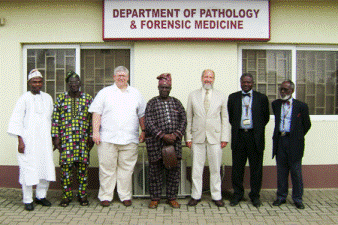Natural Resources, School of

Karl Reinhard Publications
Document Type
Article
Date of this Version
2006
Citation
Published in International Journal for Parasitology 36:13 (November 2006), pp. 1419–1425 doi:10.1016/j.ijpara.2006.07.005
Abstract
Enterobius vermicularis, pinworm, is one of the most common helminths worldwide, infecting nearly a billion people at all socio-economic levels. In prehistoric populations the paleoparasitological findings show a pinworm homogeneous distribution among hunter-gatherers in North America, intensified with the advent of agriculture. This same increase also occurred in the transition from nomad hunter-gatherers to sedentary farmers in South America, although E. vermicularis infection encompasses only the ancient Andean peoples, with no record among the pre-Colombian populations in the South American lowlands. However, the outline of pinworm paleo epidemiology has been supported by microscopic finding of eggs recovered from coprolites. Since molecular techniques are precise and sensitive in detecting pathogen ancient DNA (aDNA), and also could provide insights into the parasite evolutionary history, in this work we have performed a molecular paleoparasitological study of E. vermicularis. aDNA was recovered and pinworm 5S rRNA spacer sequences were determined from pre-Columbian coprolites (4110 BC– AD 900) from four different North and South American archaeological sites. The sequence analysis confirmed E. vermicularis identity and revealed a similarity among ancient and modern sequences. Moreover, polymorphisms were identified at the relative positions 160, 173 and 180, in independent coprolite samples from Tulán, San Pedro de Atacama, Chile (1080–950 BC). We also verified the presence of peculiarities (Splicing leader (SL1) RNA sequence, spliced donor site, the Sm antigen biding site, and RNA secondary structure) which characterize the SL1 RNA gene. The analysis shows that the SL1 RNA gene of contemporary pinworms was present in pre-Columbian E. vermicularis by 6110 years ago. We were successful in detecting E. vermicularis aDNA even in coprolites without direct microscopic evidence of the eggs, improving the diagnosis of helminth infections in the past and further pinworm paleoepidemiological studies.
Included in
Archaeological Anthropology Commons, Ecology and Evolutionary Biology Commons, Environmental Public Health Commons, Other Public Health Commons, Parasitology Commons


Comments
Copyright © 2006 Australian Society for Parasitology Inc. Published by Elsevier Ltd. Used by permission.